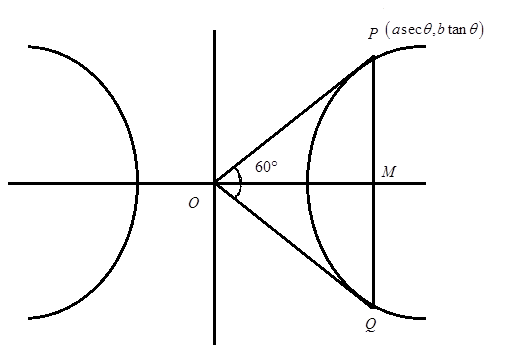Question
Question: If PQ is a double ordinate of the hyperbola \(\dfrac{{{x}^{2}}}{{{a}^{2}}}-\dfrac{{{y}^{2}}}{{{b}^{2...
If PQ is a double ordinate of the hyperbola a2x2−b2y2=1 such that OPQ is an equilateral triangle, O being the centre of the hyperbola, then the eccentricity e of the hyperbola satisfies,
A. 1<e<32
B. e=32
C. e=23
D. e>32
Solution
- Hint: We will be using the concept of hyperbola to solve the problem. We will first use the parametric form of a point on hyperbola to find a general point on hyperbola then we will use the given condition that the triangle is equilateral to find a relation between a and b and then we will be using the concept of eccentricity double ordinate to further simplify the problem.
Complete step-by-step solution -
We have been given a hyperbola a2x2−b2y2=1 and that PQ is a double ordinate such that OPQ is an equilateral triangle.

Now, we have been given that ΔOPQ is an equilateral triangle therefore, the ∠POQ=60∘.
Now, since PQ is a double ordinate therefore the ∠POM and ∠MOQ are equal due to symmetry. So, we have,
∠POM=∠MOQ=260=30∘
Now, we take the coordinate of P in parametric form as (asecθ,btanθ). Also, the coordinate of O origin is (0, 0).
Therefore, the slope OP is,
asecθ−0btanθ−0
From the formula x2−x1y2−y1=m.
Also, the slope is equal to tan 30 as we have been shown above. Therefore,
asecθbtanθ=tan30∘asecθbtanθ=31
Now, we will use the identities,
tanθ=cosθsinθsecθ=cosθ1abcosθsinθ×cosθ=31sinθ=ba×31⇒cosec θ =ab3
Now, we will square both sides to simplify it,
cosec2θ=a23b2...........(1)
Now, we know that the eccentricity of hyperbola is given by,
b2=a2(e2−1)a2b2=e2−1a2b2+1=e2
We will substitute the value of a2b2 from (1),
3cosec2θ+1=e2=cosec2θ=3(e2−1)..........(2)
Now, we know that the range of cosecθ is (−∞,−1]∪[1,∞).
So, the range of cosec2θ is cosec2θ≥1.
Now, we will use this in (2), where cosec2θ=3(e2−1).
⇒3(e2−1)≥1e2−1≥31e2≥31+1e2≥34e2>34e>±32
We will ignore the negative inequality since e > 1 for hyperbola. Therefore,
e>32 is the answer.
Hence, option (D) is correct.
Note: To solve these types of questions one must have a basic understanding of the concepts of hyperbola like double ordinate also it is important to note how we have used the condition of equilateral triangle to solve the problem.
